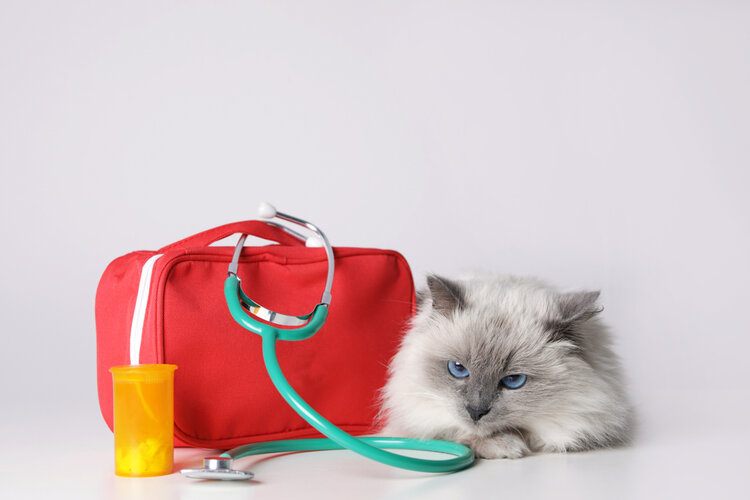No owners want to think about their precious kitties injuring themselves, but it’s a fact of life that most cats will get hurt at some point or another. That’s why it’s a great idea to make sure you have a well-stocked first-aid kit, so you can treat any minor injuries at home. Worrying that you don’t have anything to clean or treat your cat’s wounds can add extra stress to the situation.
While some human first-aid items are safe to use on your cat, others aren’t, so you should take the time to put together a feline-specific first-aid kit that has everything that you need to treat a wide range of potential issues. This list contains the items that we consider essential!
If you’re not confident about administering first aid to your cat or the wound seems more serious than you can properly treat at home, immediately call your veterinarian and see if you can bring them in right away.
The 29 Essential Items for Your Cat’s First-Aid Kit
1. Important phone numbers
You want to make sure you have any important phone numbers that you might need in case of an emergency. Tape these to the inside of your first-aid kit lid, so they’re easy to find. Dealing with an injured cat can be stressful, so the last thing you want to be worrying about is trying to find the number of your vet or googling the emergency weekend cover veterinarian. You might even be at work or on vacation and have a house-sitter looking after your animals. Leaving the essential numbers they might need will make their life much easier! We suggest having the following numbers:
- Your cat’s usual veterinarian
- Out-of-hours emergency contact for your cat’s usual veterinarian
- An alternative local veterinarian as a backup
- Pet Poison Helpline (an incident fee applies when calling the number)
2. Saline solution
Saline solution can be used as an eyewash if your kitty gets something in their eye, but it can also double as a wound wash if you need to remove grit or dirt from an open wound before disinfecting it.
You might prefer to use a specific eyewash product designed with active ingredients to soothe irritation and flush out foreign bodies from your cat’s eye.
3. Wound spray or gel
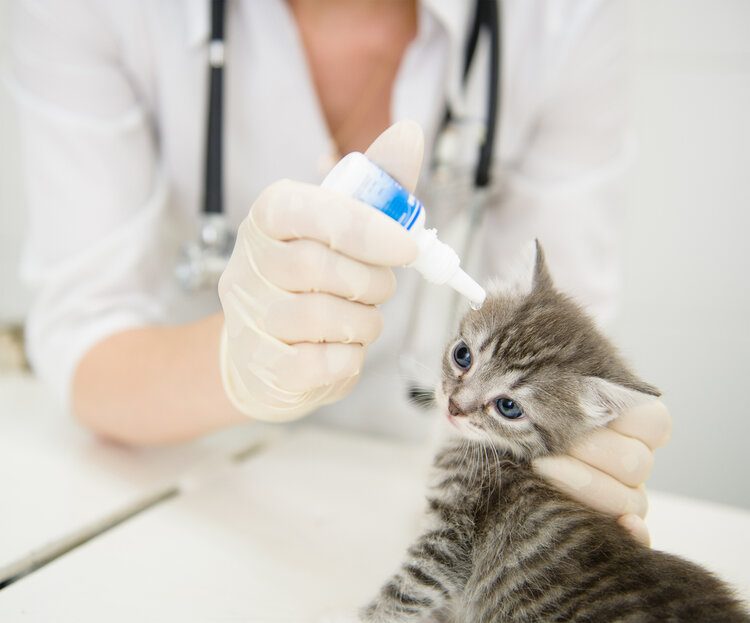
You’ll want wound spray in your first-aid kit. This helps clean small wounds and cuts. You can also get gel versions that have all the same benefits but will stick better to a wound site.
Wound spray generally contains chlorhexidine diacetate and/or povidone-iodine. Both are perfectly suitable for cleaning your cat’s wounds. Some brands will need to be diluted first, so make sure you check the label of your particular brand.
Iodine can stain skin and surfaces and be harder to apply, so wound care products containing chlorhexidine diacetate are usually more popular.
We don’t recommend hydrogen peroxide or medical-grade alcohol as wound cleaners.
4. Antiseptic cream
Antiseptic cream often contains a blend of antiseptic, antibacterial, and anti-inflammatory ingredients to help speed up wound healing and create a protective barrier as your cat’s wound heals.
5. Antiseptic wipes
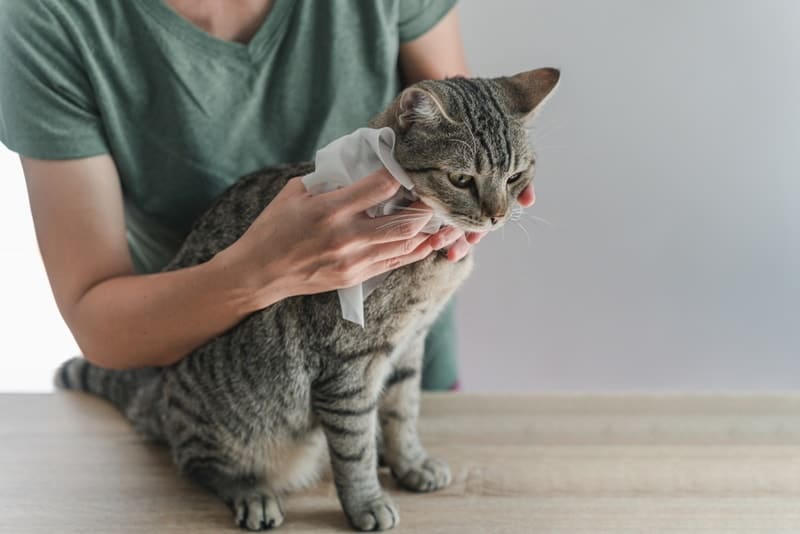
Sometimes an antiseptic wipe is easier to use than a cream, spray, or gel. Many antiseptic wipes contain chlorhexidine and can easily help clean up small scrapes.
Some also contain ketoconazole, an anti-fungal. These wipes can also be used to clean skin folds on cats with short muzzles or if your cat picks up a fungal skin infection.
It's hard to beat the convenience of pet-safe wipes after a big adventure, between baths, or when cleaning sensitive areas. Our favorite option is Hepper's Wash Wipes, premium wipes designed to safely and gently remove grime from cats and dogs of all ages and sizes. These hypoallergenic wipes are made in the USA and feature moisturizing ingredients to soothe your pet's skin. At Catster, we’ve admired Hepper for many years and decided to take a controlling ownership interest so that we could benefit from the outstanding designs of this cool cat company!
6. Styptic powder
Styptic powder can be useful for stopping minor cuts from bleeding excessively. It works by clotting the blood it comes into contact with, but it should only be used for shallow cuts. It can also be useful if you accidentally cut through to the quick of your cat’s nails when trimming them.
Hydrogen peroxide and medical-grade alcohol are widely available as wound cleaners.
However, both can damage the live tissue around your cat’s wound, compromising healing. If you use hydrogen peroxide, you can see bubbling where the hydrogen peroxide makes contact with the skin. This is often seen as a good sign that the harmful bacteria are being killed. But what the bubbles also indicate is that your cat’s healthy skin is also being destroyed. Ouch!
So, we recommend avoiding both. If you do have one or the other in your cat’s first-aid kit, now’s the perfect time to throw it in the trash and order a different wound care product.
7. Sterile small gauze pads
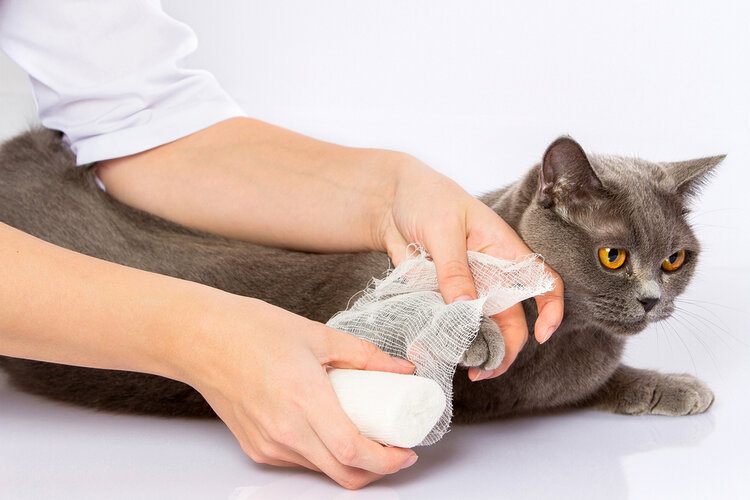
You can use these small gauze pads for cleaning out wounds without worrying about leaving fibers behind. They can also be used as an absorbent pad that you can bandage over, but they’re not non-stick, so a wound pad is sometimes a better choice.
8. Cotton ball swabs
Small cotton balls or Q-tips can be useful for cleaning out your cat’s eyes or ears or for very small wounds.
9. Non-stick wound pads
These wound pads include a perforated film over a layer of cotton. They’re great as the primary layer of a wound covering designed to absorb wound fluid, and they also won’t stick to the wound for easy removal when it comes time to change a bandage.
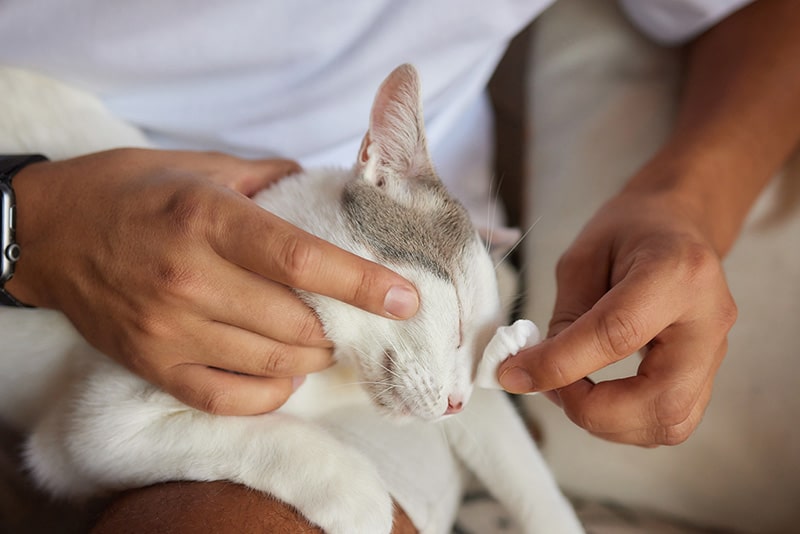
10. Self-adhering bandage
Using a self-adhering bandage over your cat’s wound once it’s cleaned and dressed is much easier than trying to tape a bandage in place. If your cat is likely to try and chew their bandage and you don’t have an E-collar at hand, you can even get self-adhesive bandages infused with a bitter (yet non-toxic!) taste that will put your cat off from trying to remove it.
11. Bandages
Gauze bandages with a 2-inch width are easiest for cat wounds. You can use this to secure a non-stick dressing in place and then apply tape or self-adhering dressing.
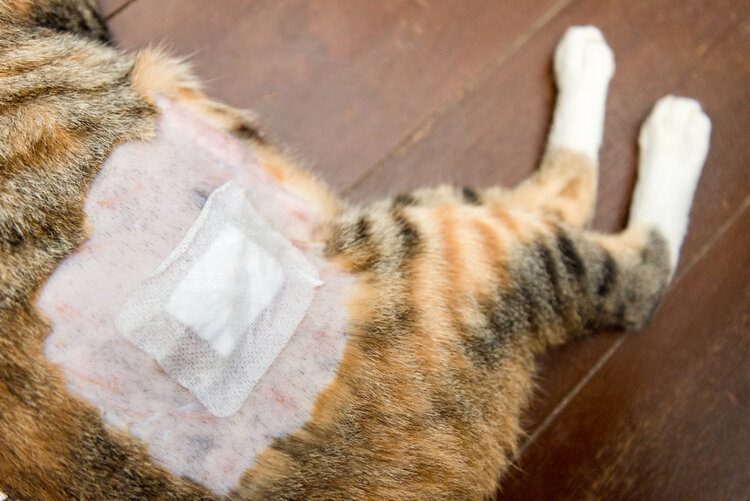
12. Tape
Tape is essential for securing bandages! Even if you plan on using a self-adhering bandage, it’s easiest to use a non-stick dressing with a small amount of gauze bandage secured with medical tape before putting the self-adhering bandage over the top.
13. Blunt-tipped scissors
If you need to cut bandages or gauze to size, it’s much better to have a set of scissors in your first-aid kit instead of raiding the kitchen drawer. Blunt-ended scissors are safest, especially if you need to use the scissors to trim your cat’s fur around a wound.
14. Cat carrier
Keeping your cat’s carrier near your first-aid kit (or even putting your first-aid kit inside the cat carrier so everyone knows where it is) is a great time saver. If your cat does need to go to the vet, having your cat carrier by your cat’s first-aid kit means you can save time.
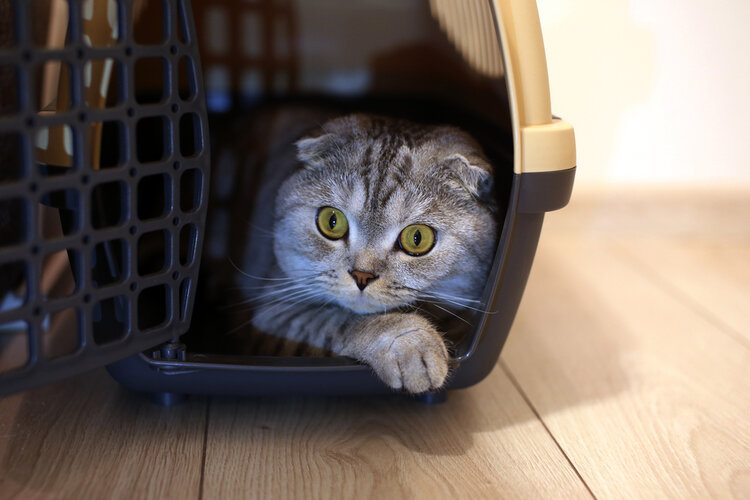
15. Medicine dropper
This can be useful if you want to clean a small wound precisely, and your antiseptic liquid is in a large bottle. By using a medicine dropper, it’s much easier to apply any antiseptic and reduce spillage.
16. Tick-removal tool
Spring and summertime can mean tick central, and the safest way to get rid of these critters is to use a removal tool designed specifically for this purpose. Simply pulling off a tick can leave the head embedded in your cat’s skin, which can increase the risk of them contracting infections like Rocky Mountain Spotted Fever or Lyme disease.
17. Nail clippers
Some cats don’t need their nails clipped too often, but others will. Keeping a small pair of cat nail clippers in your first-aid kit means it’s easy to give your cat’s nails a little trim when necessary.
Keeping your cat's paws healthy starts with keeping their nails trimmed. A great set of clippers like the Hepper Cat Nail Clipper Set can help you safely and easily do this at home. This set includes two sizes of clippers with stainless steel blades, built-in safety guards, and comfortable handles, along with a nail file and a storage pouch. Get ready for easy nail trimming! At Catster, we’ve admired Hepper for many years and decided to take a controlling ownership interest so that we could benefit from the outstanding designs of this cool cat company!
18. Tweezers
If your cat gets a grass seed caught in their fur or a splinter in their paw, then tweezers can help you accurately remove a foreign object before you treat a wound.
19. Digital thermometer
Only attempt to take your cat’s temperature rectally if your veterinarian has shown you how to do so and you feel confident attempting it. A rapid thermometer can make this as quick as possible.
You can also use an ear thermometer, and while these are more expensive, they’re also much easier to use.
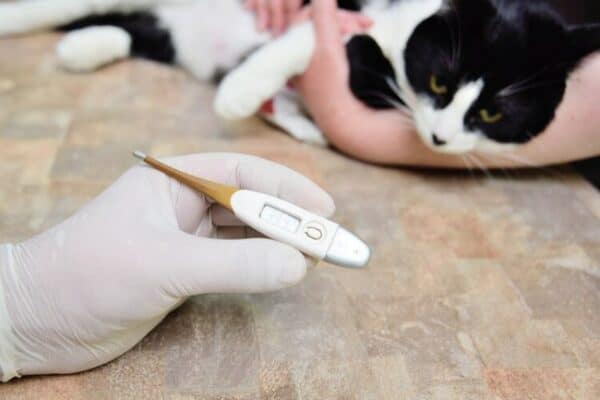
20. Petroleum jelly
If your vet does instruct you to take your cat’s temperature rectally, you’ll need petroleum jelly to make this as painless as possible for your cat.
21. Disposable gloves
If your cat is bleeding, it’s a good idea to limit cross-contamination by popping a pair of disposable gloves on before you start trying to treat them. If you’re allergic to latex or any other material used to make some types of gloves, select a brand that you won’t react to.
Using gloves will also stop any bacteria on your hands from being transferred onto your cat’s wounds.
22. E-collar
If you’ve spent ages carefully cleaning your cat’s wound and diligently applying a bandage, you don’t want your cat to rip this off with their teeth as soon as you let them go! Using an E-collar helps your cat recover faster by stopping them from bothering their wound as it heals.
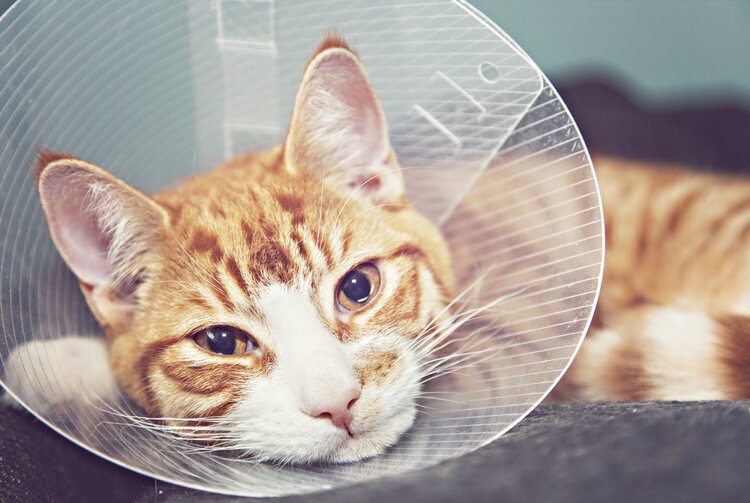
23. Towels
Towels can be useful to soak up blood if your cat has a large wound or to wrap your cat in while you administer medication or clean a cut. It’s also useful to pop into the bottom of your cat carrier if you do need to make a trip to your veterinarian.
24. First-aid guide
While you probably won’t use this in an emergency, if your cat has a wound that doesn’t require emergency treatment, it can be useful to have a reference book on hand. Choosing to pop a first-aid guide into your kit can help you feel confident about selecting a certain technique to treat your cat’s wounds. It’s always a good idea to have a quick read of this book before you put it in your first-aid kit, so you’re familiar with some of the contents.
25. Tongue depressor
If your cat has got something stuck in their throat or a bee has stung them in their mouth, it can be useful to have wooden tongue depressors at hand to try and take a closer look. In either case, your cat will likely need veterinary attention, but it can be useful to know what you’re dealing with first, as long as your cat lets you take a look!
26. Cold pack
If your cat has been stung or has unidentified swelling or inflammation, then applying an instant cold compress can help give your cat some relief while you consider what treatment they need. Make sure to wrap this in a towel rather than apply it directly to your cat’s skin. Don’t leave your cat unattended either, as these packs can contain toxic chemicals.
Don’t use these on a cat that may be suffering from heatstroke, though.
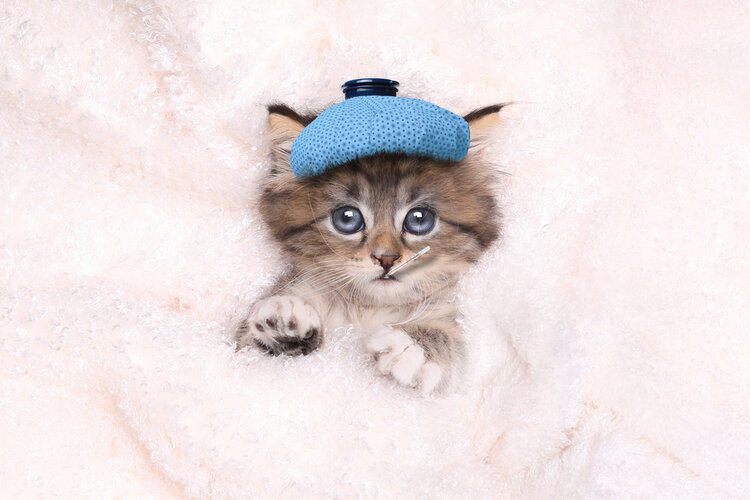
27. Muzzle
Some cats refuse to sit nicely while you try and clean their wounds. While we can’t say that we blame them, it certainly doesn’t make your job any easier! Using a restraint muzzle for a short amount of time can stop your cat from biting while you treat their injuries, and ultimately, help you finish this in less time!
28. Pill popper
If your vet prescribes oral pills for your cat, we all know how difficult those can be to administer! Cut through the challenge of giving your cat pills by using a pill popper that delivers the pill straight to the back of your cat’s mouth.
29. Oral syringes
If your vet prescribes liquid medication, some cats will refuse to eat if you try to put this on their food. If you have multiple cats, it can also be difficult to tell if the right cat has eaten the right food! Using an oral syringe can make administering liquid medications much easier.
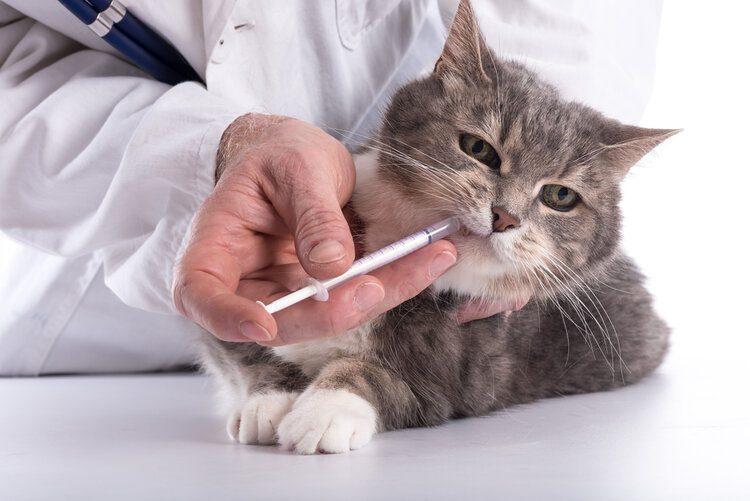
Specific Medications
If your cat has particular problems with certain health conditions, you might want to add specific items to your first-aid kit to make treating these easier. These could include ear cleaners, hot-spot ointments, allergy medication, or prescribed antibiotics.
Wrapping It Up
You might choose to buy a complete first-aid kit for your cat and then add more items to this once you’ve figured out what your cat needs specifically. This can be a great way to get started with the essentials without having to buy everything separately.
With the items we’ve listed here, you should be well prepared to deal with any minor medical attention that your cat requires!
For any more serious issues, including having to induce vomiting or dealing with a severe allergic reaction or deep wounds, don’t hesitate to call your veterinarian immediately.
Do you have all these items in your cat’s first-aid kit? Or have we missed something that you consider essential? Let us know in the comments, we’d love to hear from you!
- You might also like: Black Friday Cat Products & Supplies Deals
Featured Image Credit: New Africa, Shutterstock
Contents
- The 29 Essential Items for Your Cat’s First-Aid Kit
- 1. Important phone numbers
- 2. Saline solution
- 3. Wound spray or gel
- 4. Antiseptic cream
- 5. Antiseptic wipes
- 6. Styptic powder
- 7. Sterile small gauze pads
- 8. Cotton ball swabs
- 9. Non-stick wound pads
- 10. Self-adhering bandage
- 11. Bandages
- 12. Tape
- 13. Blunt-tipped scissors
- 14. Cat carrier
- 15. Medicine dropper
- 16. Tick-removal tool
- 17. Nail clippers
- 18. Tweezers
- 19. Digital thermometer
- 20. Petroleum jelly
- 21. Disposable gloves
- 22. E-collar
- 23. Towels
- 24. First-aid guide
- 25. Tongue depressor
- 26. Cold pack
- 27. Muzzle
- 28. Pill popper
- 29. Oral syringes
- Specific Medications
- Wrapping It Up

